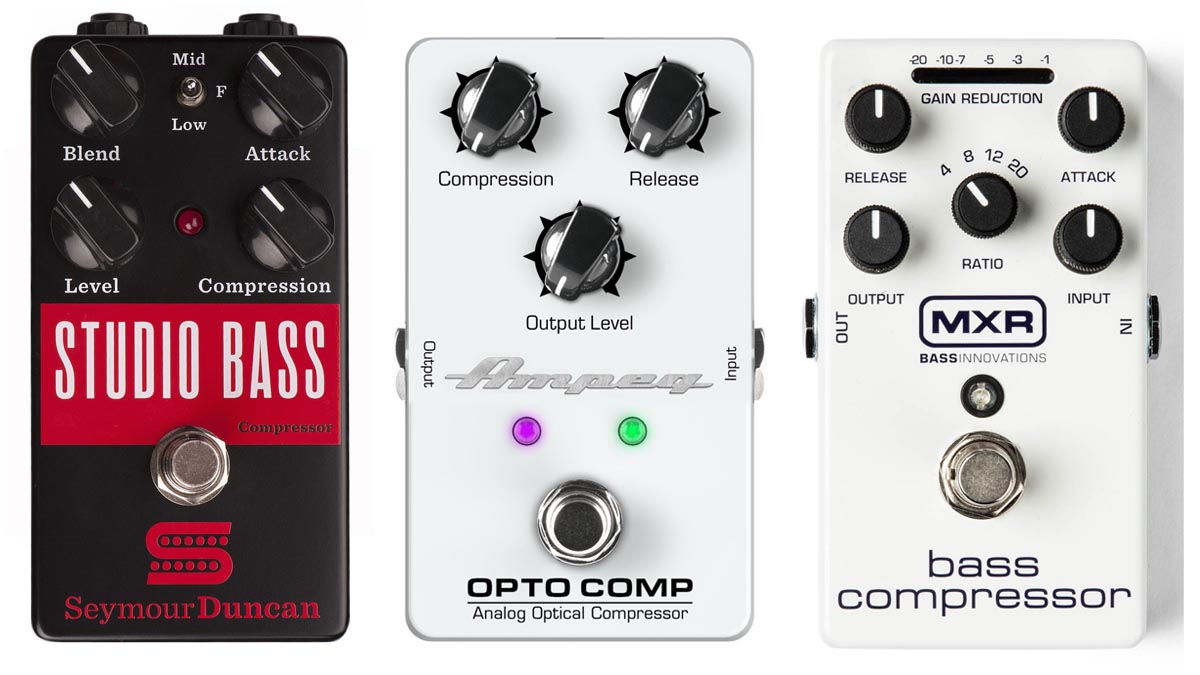How to use bass compressor pedals
The Bass Player guide to compressors and how to integrate them in your rig

Picture this: a pedalboard chock-full of effects under your feet. I’ll be dissecting that virtual pedalboard to help you craft your sound more quickly and efficiently.
Today, we’re looking at the humble compressor pedal. What does it do, how do I use it – and why the heck can’t I hear anything happening when I turn it on?
What is compression?
In simple terms, the change in volume from our quietest notes all the way up to the loudest transients we can produce is known as the dynamic range.
Compression, whether it’s in the form of a small pedal, a professional rack unit or a software plug-in on a computer, takes that dynamic range and reduces it.
Why do we do that?
Well, limiting the output signal level in comparison to the input is a good idea if you want to smooth off the peaks in your playing: it sounds professional to the ear.
Depending how much compression you apply, you can end up with anything from a subtle, almost unnoticeable difference to practically obliterating anything that resembles dynamics.
Okay, I've got a compression pedal. What do all those knobs do?
You can expect anything from a pedal with a one-control-does-all approach to a unit with as many knobs crammed on to one box as its electronics will allow. Let’s look at the different controls you may find and help you choose useful settings for each.
Get The Pick Newsletter
All the latest guitar news, interviews, lessons, reviews, deals and more, direct to your inbox!
Input level governs the level of signal into the compressor circuit, which can affect the action of the compressor itself too. Pushing the gain up will hit the compressor threshold sooner.
Threshold is the level at which the compressor starts to affect the signal. Anything below this threshold will be left alone. Personally, I like to set this so that only the loudest transients are affected, taking into consideration that when the adrenaline starts to kick in on stage, I may dig in a little harder.
Ratio: expect a range between 1:1 and infinity, depending on the design. The ratio indicates how much signal change there is after the level exceeds the threshold. For example, a 2:1 ratio means that above the threshold, each 2dB rise in volume will result in a 1dB change in signal output. A typical fixed ratio on pedals is around 4:1.
My own secret weapon is known as New York-style compression, which blends a direct signal in with compressed sound
Attack and Release controls: after you’ve exceeded the set threshold, the compressor takes hold, but using the Attack control it is possible to delay the onset of compression. That way, some initial attack can be heard at the front of the note. Conversely, Release sets the amount of time it takes for the compressor to return to normal after the signal has dropped below the threshold.
I use these controls to allow some initial attack to take place, followed by a fairly fast release – unless I’m after a ‘bowed’ effect, in which case I select a fast attack and a slow release, with compression. Note that some compressors don’t make these parameters available for user settings, presetting them internally instead.
Make-up or Output Level: naturally, if you’re reducing the dynamic range, you may notice a drop in overall volume. In that case, ‘making up’ the level is often necessary. This comes with the interesting side effect of also turning up the volume of the quieter notes, which can be a very pleasing way to add punch: essentially, the quiet notes are raised closer to the compressed peaks.
Too much boost in make-up gain due to high compression raises the noise floor, however, which can make a compressor hissy or noisy. Beware!
Multi-Band is my favourite type of compression. When I first started playing bass, compressors were just what’s known as full-band. Nowadays it’s possible to divide up your frequency range into low, mid and high bands, rather than thinking of it as one source. This way you can essentially have three different compressors acting on your signal. The effect is almost transparent when it’s set up properly.
Setting up can be confusing at first in all of the above cases. If there’s a manual with your pedal, do read it, as it may have some recommended settings for you to try. I would recommend a less-is-more approach at first, and make sure you use the appropriate volume.
The settings you use on your compressor when you’re playing through a little practice amp will seldom reap results when you hit the practice room with the full Rig Of Doom!
Recommended setup
My own secret weapon is known as New York-style compression, which blends a direct signal in with compressed sound. This may sound counter-intuitive, and it does require a slightly different approach to the settings, but as my compressor acts, it brings up the volume of quiet passages, while the presence of the direct signal allows for my transients to be left alone. This, in tandem with three-band compression, has been my secret weapon for over 20 years.
"Upgrading from your entry-level acoustic opens the door to an entirely new world of tonewoods, body shapes, and brands": 6 signs it's time to upgrade from your first acoustic guitar
"I'm past my prime": 5 common excuses for not learning the guitar – and 5 body and mind-boosting reasons you should










